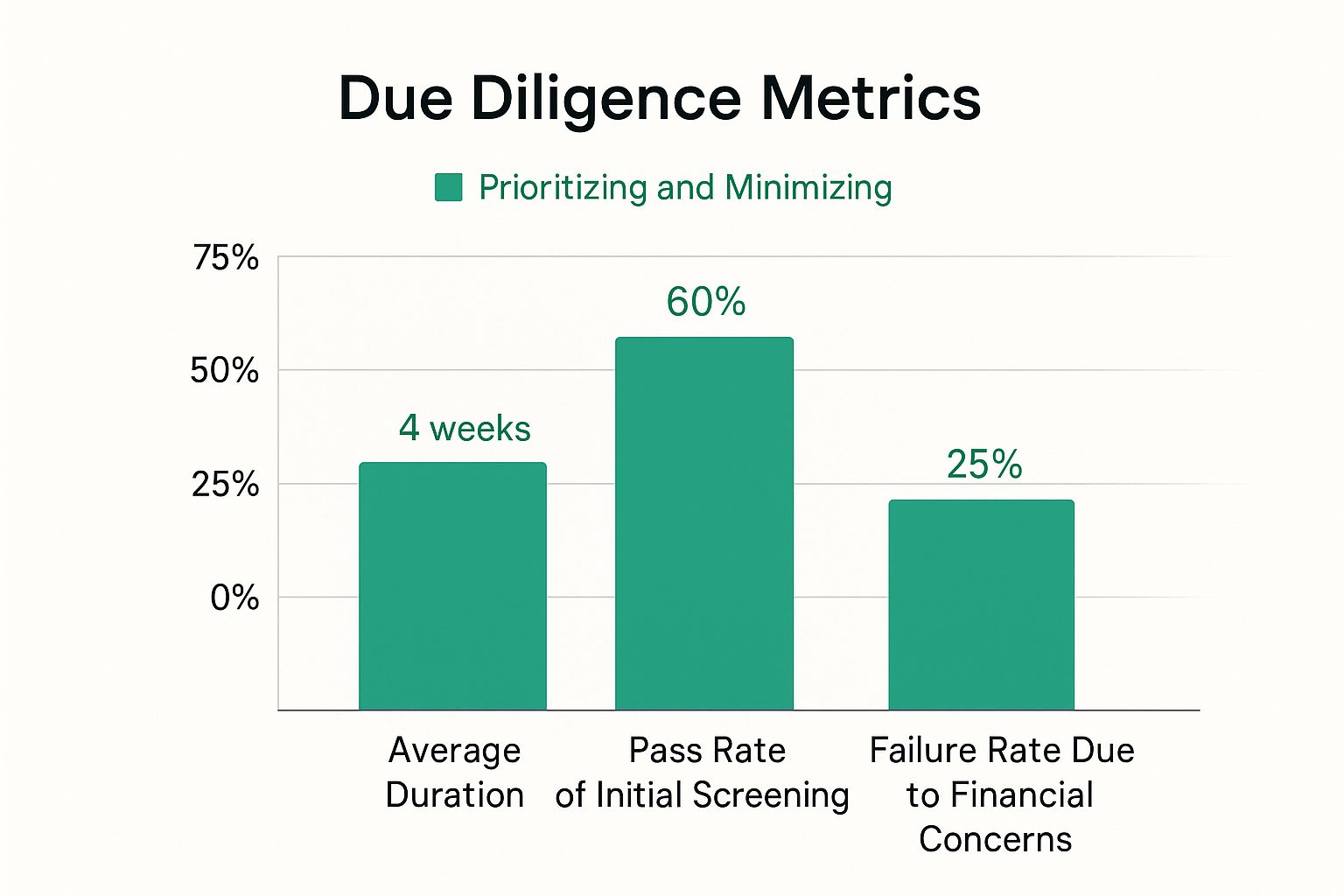Why Searching for Business Partners Transforms Growth Trajectory

Finding the right business partners is no longer a bonus; it's essential for growth. Markets are increasingly interconnected. This means companies, especially startups, often discover that collaboration significantly expands their potential. For example, a tech startup could partner with a marketing firm to connect with a larger audience.
Leveraging Shared Resources and Expertise
Partnerships are invaluable because they allow for sharing resources. This includes tangible assets like manufacturing facilities or distribution networks. It also includes intangible resources like specialized knowledge. This helps businesses, particularly resource-strapped startups, access things they couldn't afford alone.
Pooling resources also mitigates risks and achieves economies of scale. This creates a more stable financial foundation for future growth.
Expanding Market Access and Reach
Partnerships provide a powerful way to expand market reach. Collaborating with established businesses in a target market helps companies bypass the time and expense of building a new customer base.
This is especially beneficial for companies entering international markets or niche industries. A small business wanting to expand overseas could benefit from a local partner, providing immediate access to that market.
Partnerships have always been vital for business expansion. In 2024, businesses continued prioritizing partnerships for success. The growing trend of ecosystem collaborations, where multiple organizations work together to create comprehensive value chains, highlighted this. Learn more about partnership trends here: Seizing Growth Opportunities in 2025
Accelerating Innovation and Development
Partnerships also catalyze innovation. Combining diverse perspectives and skill sets allows businesses to generate new ideas and develop products and services more quickly. Think of it like an orchestra; various instruments combine to create a richer, more complete sound.
The synergy from partnerships often leads to breakthroughs. This accelerated innovation is crucial in fast-paced industries where speed to market offers a competitive advantage. Therefore, searching for the right business partners is now a key element of strategic growth for many businesses.
Defining Your Partnership North Star Before Starting the Search
Searching for the right business partner is a crucial step in any company's journey. It's much like planning a road trip: you wouldn't start driving without knowing your destination. Similarly, in the business world, a clear understanding of your needs and goals is paramount before you begin your search for a partner.
Identifying Your Capability Gaps
Before seeking external help, it's essential to take a long, hard look inwards. Honestly assess your organization's strengths and weaknesses. Where do you excel, and where are you falling short? What resources or expertise are you missing to reach your objectives? Think of it like taking inventory before a home renovation project; you need to identify what tools and materials you're lacking before heading to the hardware store. This self-awareness is the foundation for finding the right partner to bridge those gaps.
Mapping Complementary Resources for Maximum Value
Once you've identified your internal gaps, the next step is to determine which external resources would add the most value. This means understanding which partner strengths align with your needs to create a truly synergistic relationship. For example, if your software company struggles with marketing, partnering with a marketing agency HubSpot could be the solution. This allows your team to focus on what they do best – product development – while the agency handles promotion and outreach.
Establishing Crystal-Clear Partnership Objectives
Define exactly what you hope to achieve through a partnership. What are your short-term and long-term goals? Are you aiming for increased market share, access to new technologies, or entry into a new market? These objectives should be Specific, Measurable, Achievable, Relevant, and Time-bound (SMART). Having concrete goals from the beginning helps avoid misalignment and ensures everyone is working towards a shared vision. This reinforces the importance of finding partners who are equally invested in achieving these objectives.
Understanding the various partnership structures is also key. Common types include distribution partnerships, technology partnerships, and investment partnerships. Each structure serves different purposes and choosing the right one depends on your specific needs. For instance, a distribution partnership might be ideal for expanding your market reach, whereas a technology partnership could be more beneficial for collaborating on a new product.
The importance of partnerships is highlighted in the U.S. 2025 Business Leaders Outlook Report by J.P. Morgan. The report reveals that approximately 43% of business leaders plan to engage in strategic partnerships or investments in 2025.
By defining your needs, goals, and preferred partnership structure upfront, you transform the partner search from a random process into a targeted, strategic pursuit, ultimately leading to mutually beneficial growth.
Unlocking Hidden Channels For Finding Ideal Business Partners

Finding the perfect business partner is a strategic process. It's about more than just showing up at networking events. It requires understanding the various available channels and using them effectively. There are numerous ways to connect with potential partners, from traditional methods to emerging online platforms.
Traditional Channels Still Hold Value
Industry conferences, trade shows, and networking events remain valuable resources for forging partnerships. These events allow for face-to-face interactions, giving you a chance to build rapport and evaluate potential partners directly. Industry associations and chambers of commerce can also be helpful, connecting you with relevant businesses in your field. These established channels provide a structured environment for building connections.
Exploring Online Platforms and Digital Communities
Online platforms designed specifically for business connections, such as IndieMerger, are becoming increasingly important. These platforms often use algorithms to match businesses based on complementary skills and goals, streamlining the search process. For example, IndieMerger connects verified founders, which can significantly reduce search time and ensure high-quality matches.
Beyond dedicated platforms, engaging in online communities related to your industry can also uncover potential partnerships. Participating in forums, online discussions, and social media groups allows you to connect with like-minded professionals. These connections can lead to valuable collaborations and open up new opportunities.
Activating Your Network and Leveraging Connections
While making new connections is important, don't forget the power of your existing network. Reach out to your direct contacts and consider tapping into your second and third-degree connections as well. Strategic referrals and introductions can significantly expand your reach. A connection in your network might know the perfect partner you've been searching for.
Cutting-Edge Approaches for Partnership Discovery
Emerging platforms like ecosystem platforms and innovation hubs are creating new avenues for finding business partners. These collaborative environments bring together startups, corporations, investors, and researchers. This fosters innovation and creates partnership opportunities. Some innovation hubs specialize in specific industries, offering a targeted environment for finding partners with shared interests.
Choosing The Right Channel For Your Needs
The best channels for finding business partners depend on your industry, business model, and specific goals. A business-to-business (B2B) software company might find specialized online platforms more effective. Meanwhile, a consumer-facing business might find industry conferences and social media engagement more fruitful. Evaluating your needs and target audience will help you choose the right channels and maximize your chances of success.
To help you select the right approach, consider the following comparison:
To help you select the right approach, consider the following comparison:
Business Partner Search Channels Comparison
This table compares the effectiveness, time investment, and ideal use cases for different partner search methods.
| Channel Type |
Effectiveness Rating |
Time Investment |
Best For |
Key Considerations |
| Industry Conferences & Trade Shows |
Medium-High |
High (Travel & Attendance) |
Establishing initial contacts, face-to-face networking |
Cost of attendance, travel logistics, effective follow-up crucial |
| Online Business Partner Platforms (e.g., IndieMerger) |
High |
Medium (Profile creation, platform engagement) |
Targeted partner searching based on specific needs and criteria |
Platform fees, accuracy of profile information |
| Online Communities (Forums, Social Media) |
Medium |
Low-Medium (Regular participation and engagement) |
Building relationships, discovering potential collaborations organically |
Requires consistent effort, building trust within the community |
| Network Referrals |
High |
Low (Leveraging existing connections) |
Warm introductions, trusted recommendations |
Quality of network, willingness of connections to refer |
| Innovation Hubs & Ecosystem Platforms |
Medium-High |
Medium (Application process, active participation) |
Accessing specialized resources, connecting with innovative partners |
Alignment with hub's focus, competition for resources |
By understanding the strengths and weaknesses of each channel, you can create a targeted strategy for finding the right business partners. This will ultimately increase your chances of building successful and mutually beneficial collaborations.
Leveraging Technology To Transform Your Partner Search Process
Connecting with the right business partners has always been vital for growth. Technology has revolutionized this process, moving beyond traditional networking methods like cold calls. Now, businesses can leverage digital tools to find ideal partners more efficiently.
Partnership Platforms and AI-Powered Matching
Specialized partnership platforms, like IndieMerger, are transforming how businesses connect. These platforms utilize algorithms to match businesses based on shared goals, needs, and complementary strengths. IndieMerger, for example, verifies all founders, ensuring connections with committed entrepreneurs. This targeted approach saves significant time and resources.
Digital Ecosystems and Data Analytics
Beyond dedicated platforms, interconnected digital ecosystems are emerging within specific industries. These ecosystems foster collaboration and provide numerous networking opportunities. Companies are also using data analytics to identify potential partners, even those not actively seeking collaboration.
This data-driven approach reveals hidden opportunities and strengthens existing partnerships. For instance, nonprofits are using AI to improve partnership outcomes and achieve stronger ROI. This trend is expected to grow, with partnerships becoming even more sophisticated with increased AI integration by 2025. Learn more about future trends: Partnership Trends to Watch in 2025
Automation Tools for Streamlined Workflows
Automation tools are simplifying the partnership process. They manage various tasks, from initial outreach to ongoing communication, freeing up time for relationship building and strategic planning. These tools also track partnership performance, identifying areas for improvement and enabling businesses to manage multiple partnerships effectively.
Practical Implementation and ROI
Implementing these technologies is accessible to businesses of all sizes. While adopting new technology might seem complex, many platforms seamlessly integrate with existing systems. The return on investment (ROI) can be substantial, reducing search time, improving partner quality, and increasing revenue potential through collaborations. This strategic use of technology provides a competitive advantage in today's business world.
The Partnership Due Diligence Playbook That Actually Works
Finding the right business partners is crucial, but it's only the first step. Thorough due diligence is essential for separating successful partnerships from costly mistakes. Think of it like dating: initial attraction is important, but truly understanding someone’s character and values determines long-term compatibility. This process involves a deep dive into several key areas.
Assessing Compatibility Across Key Dimensions
Effective due diligence explores four core dimensions: strategic, cultural, operational, and financial. Strategic alignment ensures both partners share a common vision. Cultural fit examines how well your work styles, values, and communication approaches mesh. Operational due diligence analyzes the practical aspects of working together, such as project management styles and technology infrastructure. Finally, financial assessment evaluates the financial health and stability of each partner.
Before we dive deeper, let's take a look at the key areas you should be evaluating when considering a potential business partner. The table below provides a comprehensive framework for your due diligence process.
To help guide your evaluation, we've developed a comprehensive scorecard. This table outlines key categories, metrics, and questions to ask, as well as potential red flags to watch out for.
| Evaluation Category |
Key Metrics |
Weight |
Assessment Questions |
Red Flags |
| Strategic Alignment |
Shared Vision & Goals |
25% |
Does the partner's vision align with ours? What are their long-term objectives? How will this partnership help them achieve their goals? |
Conflicting long-term goals, lack of clarity on partnership's purpose |
| Cultural Fit |
Communication Style & Values |
20% |
How do they communicate internally and externally? What are their core values? How do their values align with ours? |
Incompatible communication styles, clashing values |
| Operational Capabilities |
Project Management & Technology |
30% |
What project management methodologies do they use? What is their technology infrastructure like? Are they adaptable to new technologies? |
Inefficient project management, outdated technology, resistance to change |
| Financial Stability |
Revenue, Profitability, Debt |
25% |
What is their financial track record? What are their current revenue and profit margins? What is their debt-to-equity ratio? |
Inconsistent financial data, high debt levels, declining revenue |
This scorecard offers a structured approach to evaluating potential partners across crucial dimensions. Remember to tailor the weights and questions to your specific needs and industry.
Going Beyond Surface-Level Information
Don't just rely on presentations and marketing materials. Proactively seek information by conducting thorough interviews with key personnel. Ask targeted questions about past partnerships, challenges faced, and lessons learned. This helps you understand their track record and potential compatibility. Technology can also play a significant role in streamlining this process. You can even explore emerging trends like AI and Predictive Analytics in Background Verification.
Verification Techniques for a Complete Picture
Gathering information is important, but verifying its accuracy is crucial. Independent research, background checks, and speaking with past partners provide valuable insights. Think of it as verifying references before hiring an employee. These verification steps confirm the information provided and can reveal potential red flags.
The infographic below visualizes some key metrics related to partnership due diligence: average duration, initial screening pass rate, and failure rate due to financial concerns.

The data highlights some important statistics: the average due diligence process takes four weeks, the initial screening has a 60% pass rate, and 25% of partnerships fail due to financial issues uncovered during the process. This underscores the importance of thorough financial assessment.
Identifying Red Flags and Deal Breakers
Experienced partnership professionals develop a keen eye for potential problems. Inconsistent financial data, negative feedback from previous partners, or a lack of clear communication are all warning signs. These red flags should be carefully investigated. Ignoring them could lead to significant issues later.
Stakeholder Involvement and Transparent Decision-Making
Due diligence shouldn't be a solo mission. Involve key stakeholders from various departments to gather diverse perspectives. Establish a clear evaluation framework with weighted criteria to ensure objective decision-making. A transparent process builds trust and sets the stage for a successful collaboration.
Crafting Partnership Agreements That Drive Mutual Success
A strong partnership agreement is the cornerstone of any successful collaboration. It transforms a promising idea into a sustainable, thriving business. This section offers practical advice on creating partnership frameworks that provide legal protection while maintaining the flexibility needed for growth.
Exploring Different Partnership Models
Just as different vehicles suit different terrains, various partnership structures cater to specific business needs. These include joint ventures, strategic alliances, licensing arrangements, and distribution partnerships. Each offers unique advantages. A joint venture, for example, might be ideal for a large project requiring shared resources and expertise. A strategic alliance, on the other hand, could involve a less formal agreement focused on joint marketing efforts.
Key Elements of Successful Agreements
Effective agreements clearly define crucial elements. Intellectual property rights outline ownership and usage of patents or trademarks. Resource commitments detail each partner's contribution, from financial investment to personnel. Performance expectations establish clear metrics and benchmarks for success. Profit-sharing mechanisms, meanwhile, define how profits are distributed, ensuring fairness and transparency. For instance, a technology partnership might detail royalty payments for a jointly developed product.
Negotiation Strategies and Pitfalls
Negotiation is a crucial process where partners balance protecting their interests with building trust. Open communication, flexibility, and a willingness to compromise are essential. However, certain pitfalls can derail partnerships before they even begin. Unrealistic expectations or a lack of clarity regarding roles and responsibilities can create friction. Effective vendor management is also crucial when establishing partnerships.
Exit Strategy Frameworks
Similar to a prenuptial agreement, an exit strategy provides security in a business partnership without creating unnecessary tension. It outlines the process for dissolving the partnership, addressing issues like asset division, ownership transfer, and dispute resolution. This safety net allows partners to focus on growth, knowing there's a clear path forward should the partnership need to end.
Actionable Templates and Checklists
Navigating the complexities of partnership agreements can be challenging. Actionable templates and checklists provide invaluable structure. These resources ensure all key elements are addressed, streamlining the process and minimizing the risk of oversight. This structured approach builds a solid foundation for thriving collaborations. This is particularly helpful for businesses seeking partners, as it helps create agreements that drive mutual success, protect both parties, and lay the groundwork for a productive and profitable partnership.
Transforming New Partnerships Into Lasting Growth Engines

Finding the right business partners is a crucial first step. But the real journey begins after the initial excitement settles. This is the phase where you transform those new partnerships into sustainable engines for long-term growth. It demands consistent nurturing and a shared commitment to building a mutually beneficial relationship. This section explores proven strategies to cultivate these partnerships beyond the initial "honeymoon phase."
Communication Frameworks for Continuous Alignment
Open and consistent communication is the bedrock of any successful partnership. Think of it as the navigation system guiding your shared journey. Clear communication ensures both partners stay on course, even when facing unexpected challenges.
Regular meetings and check-ins are essential. These provide a platform to discuss progress, address obstacles, and maintain strategic alignment. Go beyond simple status updates. Use these opportunities for brainstorming, problem-solving, and strategic planning to reaffirm shared goals and adapt to the ever-shifting market dynamics.
Governance Structures That Balance Autonomy and Accountability
Effective partnerships require a delicate balance between independent action and shared accountability. A well-defined governance structure provides this essential balance. It outlines decision-making processes, clearly defines roles and responsibilities, and establishes reporting procedures.
This structure serves as a blueprint for collaboration, ensuring both partners understand their individual contributions and how they will work together cohesively. This clarity promotes efficient operations and minimizes the potential for conflicts.
Conflict Resolution Approaches That Strengthen Relationships
Disagreements are an inevitable part of any partnership. However, how these disagreements are handled can significantly impact the relationship’s strength and longevity. Establishing a clear process for conflict resolution is key.
This process should emphasize open communication, mutual respect, and a solution-oriented approach that benefits both parties. A proactive approach to conflict resolution, rather than a reactive one, can transform potential disagreements into opportunities for growth and understanding.
Mutual Growth Objectives and Performance Systems
Establish shared goals that drive mutual benefit. These mutual growth objectives inject energy into the partnership and create a unified sense of purpose. Implementing joint performance systems is crucial for tracking progress, pinpointing areas for improvement, and celebrating shared successes.
This shared accountability reinforces the partnership and keeps both parties laser-focused on achieving their common goals. For instance, if one partner develops new technology, the agreement could detail how the other partner will use that technology to bolster their marketing efforts, creating a win-win scenario for both.
Adapting Partnerships to Evolving Market Conditions
The business world is in constant flux. Partnerships must be flexible and adaptable to thrive in this dynamic environment. Regularly review the partnership agreement, reassessing its relevance to current market conditions.
Don't hesitate to adjust strategies, redefine goals, or explore new avenues for collaboration. Embracing change and adapting proactively will ensure your partnership remains resilient and successful.
Reinforcing Commitment and Recognizing When to Evolve
Just like personal relationships, business partnerships require continuous effort and reinforcement. Celebrate milestones, acknowledge each other's contributions, and regularly reaffirm the shared vision.
However, it's equally important to recognize when a partnership needs to evolve or perhaps even conclude. Sometimes, despite the best intentions, partnerships reach a natural end. Having a clear exit strategy in place ensures a smooth transition, preserving the positive aspects of the relationship.
Finding business partners is just the first step. Nurturing these relationships effectively is what transforms them into powerful growth engines. By implementing these strategies, you can ensure that every partnership contributes significantly to your long-term success. Ready to find the perfect business partner to accelerate your growth? IndieMerger connects verified founders with complementary skills, empowering entrepreneurs to build their startups more efficiently.